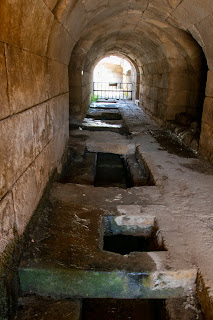The Golan Heights is a place of incredible Israel history, filled with conquests, epic battles, and important lessons.
"Golan" is mentioned in Deuteronomy 4:43, Joshua 20:8, and 1 Chronicles 6:71 as a city of refuge in Bashan. Throughout Biblical times, the Golan was a focus of a power struggle between the Israelites and the ancient Arameans from near Damascus.
King Ahab of Israel defeated Ben Hadad I of Damascus near Afik (pictured above) and years later, Elisha prophesied the victory of King Jehoash of Israel over Ben Hadad III of Damascus.
Jewish exiles from the Babylonia settled here in the 5th and 6th centuries BC, and during the inter-Testamental period, Judah Maccabee and his brothers came to the aid of Jewish settlements there (above info found here).
By 1st century AD, Gamla was the capital of the Golan, and fell as the last Jewish stronghold to resist the Romans in 67 AD.
Despite the fall of Gamla, Jewish settlement continued to grow in the Golan, and during the Byzantine Era (4th-7th centuries AD), Jewish settlement in the Golan Heights reached its peak. During that time, 27 different towns (with synagogues) were built up along the area. And after the Six Day War in 1967, excavation began. Over the next few weeks, we'll look at a series of locations throughout the Golan that tell part of its incredible story.
First of all, the meaning of the Talmudic Era. The Talmud is a set of teachings and commentaries on the Torah that form the basis for Jewish law. It was written during the time of the Byzantine Era, hence the name
In the city of Katzrin is lies the ancient Talmudic village of Katzrin. It's a really cool interactive park where people can go, learn about things like the olive press, wine press, and threshing grain, while also touring ruins from the Talmudic era. There's a village and the remains of a synagogue!
These areas were fun, but I enjoyed most walking through the ruins (of course):
And we got a surprise at the synagogue—a modern day ceremony!
Stay tuned for next week—Afik!

























































